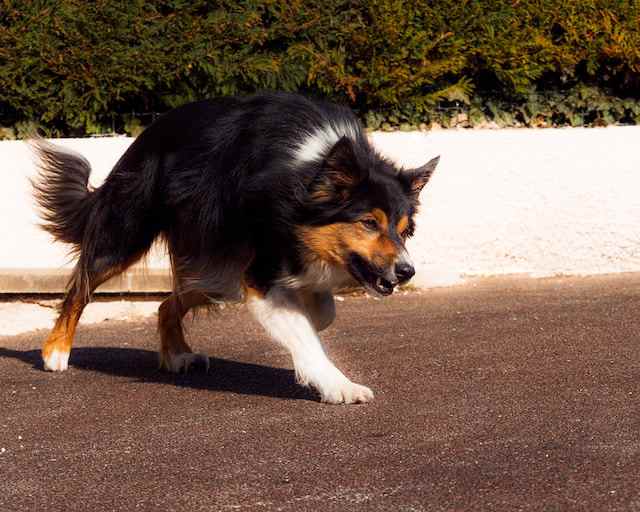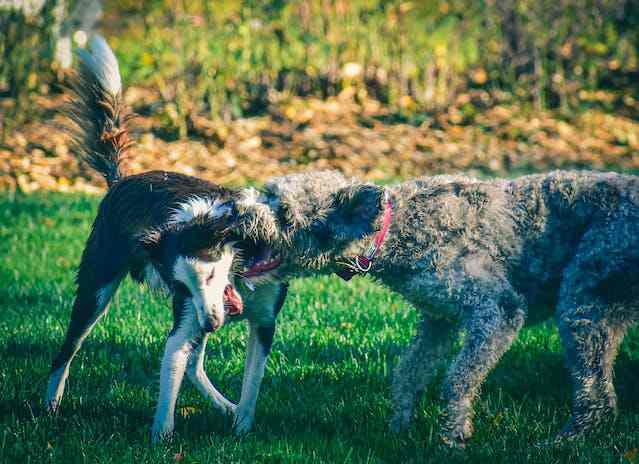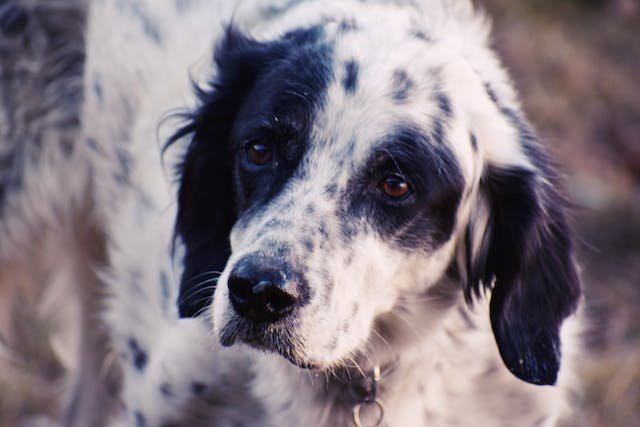Today, let’s dive into a topic that can be a bit puzzling but oh-so-important: redirected aggression in dogs.
Picture this: your furry friend, who is usually a sweetheart, suddenly lashes out at you or another innocent bystander. What’s going on?
Stay tuned as we unravel the mystery behind this fascinating canine behavior.
What is Redirected Aggression in Dogs
Redirected aggression in dogs refers to a situation where a dog redirects its aggressive behavior toward a target other than the original source of its frustration or arousal.
This can happen when a dog is unable to reach the intended target or when it becomes overwhelmed by a stimulus.
Common triggers for redirected aggression include territorial disputes, frustration, fear, or pain.
It is important to address the underlying cause of the aggression and provide appropriate training and management techniques to prevent future incidents.
Consequences of Redirected Aggression in Dogs
Redirected aggression in dogs can have serious consequences. Firstly, it can lead to injuries or even fatalities, as the redirected aggression can be intense and unpredictable.
Secondly, it can damage the bond between the dog and its owner or other family members, as the dog may associate them with the triggering event.
Thirdly, it can create fear and anxiety in the dog, as it learns that its aggression is ineffective in resolving the initial conflict. Fourthly, it can cause behavioral issues, as the dog may become more reactive and aggressive in future situations.
Fifthly, it can result in legal issues if the dog causes harm to other people or animals. Lastly, it highlights the importance of proper training and socialization to prevent or manage redirected aggression in dogs.
Signs of Redirected Aggression in Dogs

Redirected aggression in dogs can be concerning and potentially dangerous. Here are some major signs that may indicate redirected aggression in dogs:
1. Sudden Aggression: A dog experiencing redirected aggression may display an abrupt and intense aggressive outburst towards a different target, such as another dog, a person, or an object. The aggression may appear disproportionate to the triggering event.
2. Trigger Proximity: The dog may exhibit redirected aggression when it is unable to access the original source of frustration or arousal. For example, if a dog becomes frustrated by seeing another dog through a window but cannot physically reach it, it may redirect its aggression towards a person or another animal in close proximity.
3. Displacement Behaviors: Displacement behaviors are often observed when a dog is conflicted or frustrated. In the context of redirected aggression, you might notice the dog engaging in displacement behaviors, such as excessive licking, yawning, or pacing before or after the aggressive outburst.
4. Growling, Barking, or Snapping: Dogs experiencing redirected aggression may vocalize their distress by growling, barking, or snapping at a target that is different from the original source of frustration. These vocalizations and warning signs are the dog’s way of communicating its discomfort.
5. Dilated Pupils and Stiff Body Language: During a redirected aggression episode, a dog’s body language may change. Dilated pupils, stiff posture, raised hackles, and a tense facial expression are common signs that indicate the dog’s heightened state of arousal.
6. Lack of Warning Signs: Redirected aggression can sometimes occur without obvious warning signs, such as a warning growl or snarl. This sudden aggression can catch owners or bystanders off guard, making it important to be cautious around a dog displaying signs of aggression.
Causes of Redirected Aggression in Dogs
Redirected aggression in dogs occurs when a dog is unable to direct its aggressive response towards the original object or person that triggered it.
Here are some of the major causes of redirected aggression in dogs:
1. Frustration: Dogs may become frustrated when they are unable to reach their intended target, such as another dog, animal, or person. This frustration can lead to redirected aggression towards a third party.
2. Fear: Dogs may exhibit redirected aggression when they encounter unfamiliar stimuli or experiences that they associate with unpleasant events. This can include encountering new people, animals, or loud noises.
3. Resource Guarding Instinct: Redirected aggression can occur when a dog is guarding a valuable resource, such as food, toys, or territory. If the dog is prevented from accessing or protecting the resource, it may redirect its aggression towards another dog or person.
4. Overstimulation: Dogs that become highly aroused and excited by a stimulus, such as seeing an outdoor animal through a window or hearing a loud noise, may redirect their aggression towards a nearby person or animal.
5. Interference by Handler: In some cases, a dog may redirect its aggression towards its handler if the handler interferes during a highly aroused or frustrated state. This can occur when the handler attempts to attract the dog’s attention or uses physical corrections.
6. Lack of Socialization: Dogs that have not been properly socialized may exhibit redirected aggression when faced with new or unfamiliar situations. This can be a result of genetics or a lack of early socialization experiences.
Managing Redirected Aggression in Dogs

Redirected aggression in dogs can be a challenging behavior to address and manage. Here are some effective ways to address and manage redirected aggression in dogs:
1. Identify and Remove Triggers: It is important to identify the triggers that lead to redirected aggression in your dog. These triggers can include other animals, unfamiliar people, or certain situations. Once you have identified the triggers, try to remove or avoid them as much as possible to prevent the occurrence of redirected aggression.
2. Provide a Safe Environment: Creating a safe environment for your dog is crucial in managing redirected aggression. This can include using baby gates or crates to separate your dog from potential triggers, ensuring that your dog has a quiet and comfortable space to retreat to, and avoiding situations that may cause stress or anxiety for your dog.
3. Avoid Punishment: Punishing a dog for redirected aggression can worsen the behavior and increase fear or anxiety. Instead, focus on positive reinforcement and reward-based training methods. Reward your dog for calm and non-aggressive behavior, and redirect their attention to more appropriate activities or toys.
4. Implement Desensitization and Counterconditioning: Desensitization and counterconditioning techniques can be effective in managing redirected aggression. These techniques involve gradually exposing your dog to the trigger that causes aggression while providing positive experiences and rewards. This helps your dog associate the trigger with positive outcomes, reducing their aggressive response over time.
5. Ensure Proper Socialization: Proper socialization is crucial for dogs to learn appropriate behavior and develop good social skills. Expose your dog to a variety of people, animals, and environments from a young age, using positive reinforcement techniques. This can help reduce fear and anxiety, which are common triggers for redirected aggression.
6. Consider Medication: In some cases, medication may be recommended by a veterinarian or veterinary behaviorist to help manage redirected aggression. Medication can help reduce anxiety or fear-related behaviors, making it easier to implement behavior modification techniques. However, medication should always be used under the guidance of a professional.
7. Seek Professional Help: If redirected aggression persists or becomes a safety concern, it is advisable to seek the help of a professional dog trainer or behaviorist. They can assess the situation, provide guidance on behavior modification techniques, and develop a tailored training plan to address the specific needs of your dog.
Remember, each dog is unique, and what works for one may not work for another. It is important to be patient, consistent, and observant when addressing aggression in dogs. If you have concerns about your dog’s behavior, consult with a professional to ensure the safety and well-being of both your dog and those around them.
Preventing Redirected Aggression in Dogs

To prevent redirected aggression, it is essential to understand the underlying causes and implement appropriate measures.
Firstly, it is crucial to identify triggers that may lead to redirected aggression and avoid exposing the dog to those situations. This may involve keeping the dog away from potential sources of frustration or conflict.
Secondly, providing proper socialization and training for the dog can help prevent redirected aggression. This includes exposing the dog to various environments, people, and animals from an early age, teaching them appropriate behavior, and reinforcing positive interactions.
Thirdly, using positive reinforcement techniques during training can help redirect the dog’s focus and reinforce desirable behaviors. This can include rewarding the dog for calm and non-aggressive responses when faced with potential triggers.
Fourthly, ensuring the dog receives regular exercise and mental stimulation can help reduce stress and prevent redirected aggression. Physical activities and interactive toys can help release excess energy and provide an outlet for frustration.
Lastly, creating a safe and secure environment for the dog is crucial. This may involve using baby gates or crates to separate the dog from potential triggers and providing a designated space where the dog can feel calm and secure.
By implementing these measures, pet owners can effectively prevent aggression in dogs and promote a safe and harmonious environment for both the dog and those around them.
Frequently Asked Questions
What are the common triggers for redirected aggression in dogs?
Redirected aggression can be triggered by a variety of factors, including territorial disputes, frustration from being restrained, or being unable to access a desired resource such as food or toys. Other dogs or people who happen to be in the vicinity can become unintended targets of the dog’s redirected aggression.
How can I recognize redirected aggression in my dog?
Redirected aggression can be challenging to identify, as it can happen suddenly and seemingly without warning. Signs of redirected aggression may include sudden growling, snapping, or biting towards another dog or person, even if there was no prior aggression or confrontation.
How should I handle redirected aggression in my dog?
If your dog displays redirected aggression, it’s important to prioritize safety for both your dog and others. Avoid physically intervening or punishing your dog, as it may escalate the situation. Instead, try to remove the source of frustration or arousal and create distance between your dog and the trigger. Consult a professional dog trainer or behaviorist for guidance on managing and modifying this behavior.
Can redirected aggression be prevented?
While redirected aggression can be challenging to prevent entirely, there are steps you can take to minimize the likelihood of it occurring. These include providing adequate mental and physical stimulation for your dog, avoiding situations that may trigger frustration or arousal, and ensuring your dog has appropriate outlets for their energy and natural instincts.
Should I seek professional help for redirected aggression in my dog?
It is highly recommended to seek professional help if your dog displays redirected aggression. A qualified dog trainer or behaviorist can assess the situation, determine the underlying causes, and develop a tailored behavior modification plan to address the issue. Their expertise and guidance will help ensure the safety and well-being of your dog and those around them.
Conclusion
In conclusion, redirected aggression in dogs is a complex behavior that can be triggered by a variety of factors. Remember to always prioritize safety and seek professional guidance if you notice signs of redirected aggression in your furry friend. By understanding the root causes and implementing proper training techniques, we can create a harmonious environment for both our dogs and ourselves.


